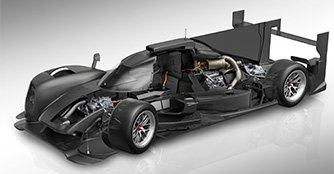How the hybrid technology of the Porsche LMP1 race car works
28 Jul 2016|1,295 views
Last weekend, the Le Mans Prototype Porsche 919 Hybrid had its only 2016 appearance in Germany. At the six-hour race at the Nurburgring, the fourth round of the FIA World Endurance Championship, the series' leader fought for points for its title defence. At the same time its mission is the technology of future sports cars.
With the 919 Hybrid, Porsche has developed a new field of technology at racing speed. For the 'Mission E', a fully electric road-going concept sports car unveiled in 2015, the designers adopted the 800-Volt technology from the prototype racer. Porsche has exhausted all possibilities in designing the two-time Le Mans winner - especially in terms of the drive concept. It consists of the 2.0-litre, V4 turbocharged petrol engine, the most efficient combustion motor that Porsche has built up to now, and two different energy recovery systems.
During braking, a generator at the front axle converts the car's kinetic energy into electrical energy. In the split exhaust system, one turbine drives the turbocharger while another converts surplus energy into electrical energy. The braking energy contributes 60 percent, with the remaining 40 percent coming from exhaust gas. The recuperated electrical energy is stored temporarily in a lithium-ion battery and feeds an electric motor on demand. 'On demand' means: the driver wants to accelerate and calls up the energy at the press of a button. In accordance with the latest regulation changes, the power from the combustion engine is just under 493bhp, and the output from the electric motor is well over 395bhp.
The use and interplay of these two energy sources require a sophisticated strategy. In every braking phase, energy is won - that is, recuperated. On the Nurburgring's 5.148km Grand Prix circuit this happens 17 times per lap, before every corner. The amount of recovered energy depends on the severity of the braking manoeuvre, or in other words, the speed at which the driver arrives at the corner and how tight it is. Braking and recuperation last until the apex of every corner, the driver then accelerates again. In this moment, the aim is to utilise as much energy as possible. Hence, the driver steps on the throttle pedal using fuel energy, and also 'boosts' electrical energy from the battery.
While the combustion engine drives the rear axle, the electric motor takes care of the front axle. The 919 catapults out of the corner without any loss of traction using all-wheel drive - and in the process recuperates energy again because on the straights the extra turbine in the exhaust tract is hard at work. At constantly high engine speeds, the pressure in the exhaust system increases rapidly and drives the second turbine connected directly to an electric generator.
Last weekend, the Le Mans Prototype Porsche 919 Hybrid had its only 2016 appearance in Germany. At the six-hour race at the Nurburgring, the fourth round of the FIA World Endurance Championship, the series' leader fought for points for its title defence. At the same time its mission is the technology of future sports cars.
With the 919 Hybrid, Porsche has developed a new field of technology at racing speed. For the 'Mission E', a fully electric road-going concept sports car unveiled in 2015, the designers adopted the 800-Volt technology from the prototype racer. Porsche has exhausted all possibilities in designing the two-time Le Mans winner - especially in terms of the drive concept. It consists of the 2.0-litre, V4 turbocharged petrol engine, the most efficient combustion motor that Porsche has built up to now, and two different energy recovery systems.
During braking, a generator at the front axle converts the car's kinetic energy into electrical energy. In the split exhaust system, one turbine drives the turbocharger while another converts surplus energy into electrical energy. The braking energy contributes 60 percent, with the remaining 40 percent coming from exhaust gas. The recuperated electrical energy is stored temporarily in a lithium-ion battery and feeds an electric motor on demand. 'On demand' means: the driver wants to accelerate and calls up the energy at the press of a button. In accordance with the latest regulation changes, the power from the combustion engine is just under 493bhp, and the output from the electric motor is well over 395bhp.
The use and interplay of these two energy sources require a sophisticated strategy. In every braking phase, energy is won - that is, recuperated. On the Nurburgring's 5.148km Grand Prix circuit this happens 17 times per lap, before every corner. The amount of recovered energy depends on the severity of the braking manoeuvre, or in other words, the speed at which the driver arrives at the corner and how tight it is. Braking and recuperation last until the apex of every corner, the driver then accelerates again. In this moment, the aim is to utilise as much energy as possible. Hence, the driver steps on the throttle pedal using fuel energy, and also 'boosts' electrical energy from the battery.
While the combustion engine drives the rear axle, the electric motor takes care of the front axle. The 919 catapults out of the corner without any loss of traction using all-wheel drive - and in the process recuperates energy again because on the straights the extra turbine in the exhaust tract is hard at work. At constantly high engine speeds, the pressure in the exhaust system increases rapidly and drives the second turbine connected directly to an electric generator.
Latest COE Prices
April 2025 | 1st BIDDING
NEXT TENDER: 23 Apr 2025
CAT A$97,724
CAT B$117,899
CAT C$68,782
CAT E$117,002
View Full Results Thank You For Your Subscription.


















